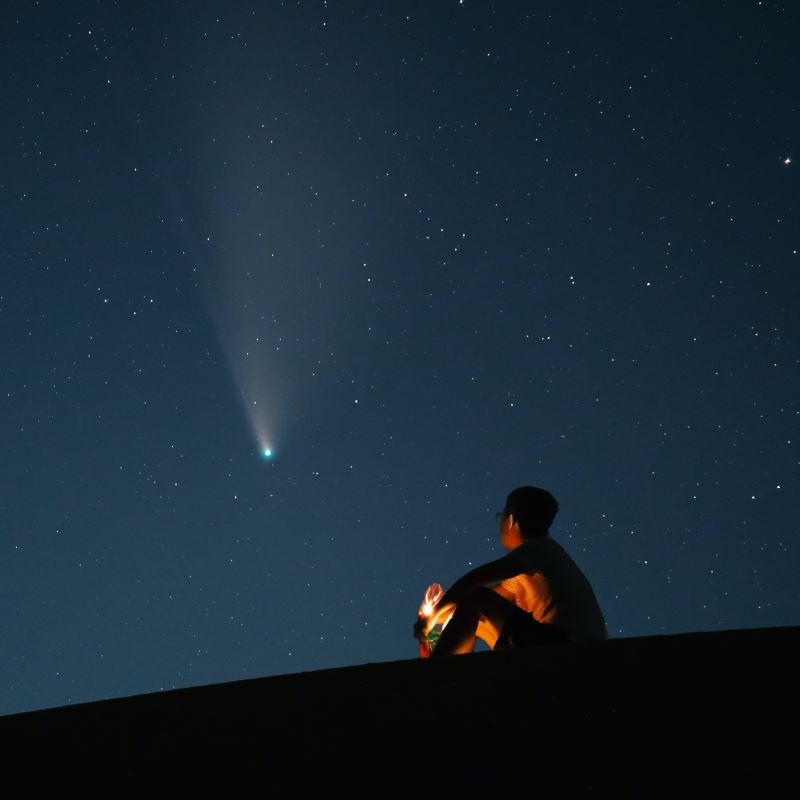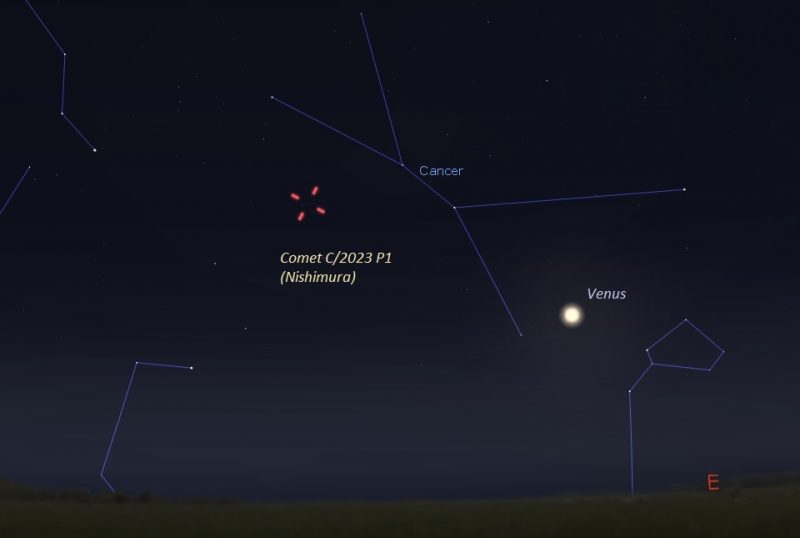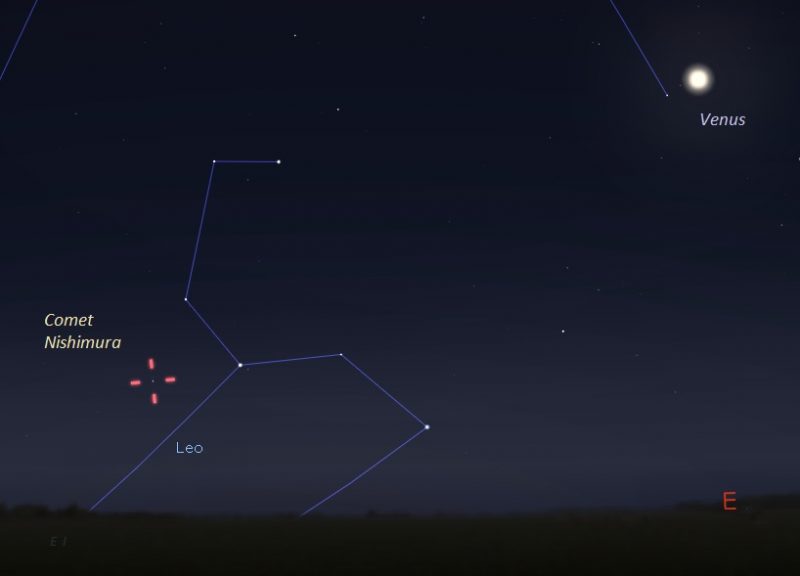
Hideo Nishimura of Kakegawa, Japan, was photographing the night sky on August 11 and 12, 2023, when he captured a new comet that now bears his name. Comet C/2023 P1 Nishimura is currently moving in front of the constellation Gemini the Twins, low in the dawn sky. The comet was hiding in the sun’s glare before Nishimura picked it up in his images. And, by next month, it might be bright enough to see with the unaided eye!
Some estimates already put the comet at magnitude 10.4, which means people using six-inch telescopes or larger in a dark sky can spot it. Other observations report that the comet’s tail is eight arcminutes long. The comet should continue to brighten and the tail to grow as it nears the sun. The comet will be at its brightest in mid-September when it’s closest to the sun and Earth.
Comet Nishimura is racing toward the sun
By August 15-16, 2023, the comet was already passing Earth’s orbit as it’s approaching the sun. Comet Nishimura is traveling so fast that it will reach Venus’ orbit in just a few days … by August 27, 2023.
Sky enthusiasts can observe the comet with a small telescope during the remaining days of August (see the charts below). It’s best to try to see it now, because it may not survive its passage near the sun. This is due to its extremely close pass to our star. Comet Nishimura will pass closer to the sun than Mercury’s orbit. If it does survive through August, Comet Nishimura should become a binocular object during the first mornings of September. Then, observers with an unobstructed view to the east-northeastern horizon might get good binocular views of Comet C/2023 P1 (Nishimura) around September 10, some 45 minutes before sunrise.
The path of the new comet
Comet Nishimura is taking a tour of the zodiacal constellations. It will move from Gemini into the constellation of Cancer in late August and early September. It will traverse Leo in the middle of September and then visit Virgo in the second half of September.
How bright will the comet be?
It’s always challenging to estimate a comet’s brightness because they’re so unpredictable. While Comet Nishimura could be bright enough to see with the unaided eye, it could also fall apart as it nears the sun. But here’s an approximation of how bright the comet will be on certain dates and where to find it.
Starwalk is estimating the comet to be magnitude 4.9 – within range of the unaided eye – on September 11. On the morning of September 11, you can look for the comet before dawn. The first object you’ll notice in the eastern sky is a crescent moon, followed by brilliant Venus nearby. The comet will be near the pair and close to the star Adhafera (Zeta Leonis) in Leo’s Sickle (backward question mark).
The comet’s closest approach to Earth is on September 13, when it’s 0.29 AU away. Around this time, the comet transitions from being a morning object to an evening object. On September 15, the comet will be just 10 arcminutes from the second brightest star in Leo, Denebola. But the pair will also be just 12 degrees from the sun, making it difficult to catch them after sunset before they set themselves.
Starwalk estimates the comet at magnitude 3.2 during perihelion – when the comet is closest to the sun – on September 18. Of course, when the comet is bright and close to the sun, it will be difficult to see because it will be close to the sun on the dome of our sky as well, meaning sunlight will wash out nearby objects. Observers in the Northern Hemisphere have the best shot to see the comet after sunset on September 18 in Virgo.
Maps for new comet C/2023 P1





Saying goodbye to Comet Nishimura
As the comet pulls away from the sun, it will fade in brightness. By mid-October it will be farther from the sun in our sky (20 degrees) but becoming dimmer. How long can you follow Nishimura as it exits?
Bottom line: A new comet, named Nishimura, may be bright enough to see with the unaided eye in September. Learn how to see it here.
The post New comet C/2023 P1 Nishimura to brighten in September first appeared on EarthSky.
from EarthSky https://ift.tt/mAkiptM

Hideo Nishimura of Kakegawa, Japan, was photographing the night sky on August 11 and 12, 2023, when he captured a new comet that now bears his name. Comet C/2023 P1 Nishimura is currently moving in front of the constellation Gemini the Twins, low in the dawn sky. The comet was hiding in the sun’s glare before Nishimura picked it up in his images. And, by next month, it might be bright enough to see with the unaided eye!
Some estimates already put the comet at magnitude 10.4, which means people using six-inch telescopes or larger in a dark sky can spot it. Other observations report that the comet’s tail is eight arcminutes long. The comet should continue to brighten and the tail to grow as it nears the sun. The comet will be at its brightest in mid-September when it’s closest to the sun and Earth.
Comet Nishimura is racing toward the sun
By August 15-16, 2023, the comet was already passing Earth’s orbit as it’s approaching the sun. Comet Nishimura is traveling so fast that it will reach Venus’ orbit in just a few days … by August 27, 2023.
Sky enthusiasts can observe the comet with a small telescope during the remaining days of August (see the charts below). It’s best to try to see it now, because it may not survive its passage near the sun. This is due to its extremely close pass to our star. Comet Nishimura will pass closer to the sun than Mercury’s orbit. If it does survive through August, Comet Nishimura should become a binocular object during the first mornings of September. Then, observers with an unobstructed view to the east-northeastern horizon might get good binocular views of Comet C/2023 P1 (Nishimura) around September 10, some 45 minutes before sunrise.
The path of the new comet
Comet Nishimura is taking a tour of the zodiacal constellations. It will move from Gemini into the constellation of Cancer in late August and early September. It will traverse Leo in the middle of September and then visit Virgo in the second half of September.
How bright will the comet be?
It’s always challenging to estimate a comet’s brightness because they’re so unpredictable. While Comet Nishimura could be bright enough to see with the unaided eye, it could also fall apart as it nears the sun. But here’s an approximation of how bright the comet will be on certain dates and where to find it.
Starwalk is estimating the comet to be magnitude 4.9 – within range of the unaided eye – on September 11. On the morning of September 11, you can look for the comet before dawn. The first object you’ll notice in the eastern sky is a crescent moon, followed by brilliant Venus nearby. The comet will be near the pair and close to the star Adhafera (Zeta Leonis) in Leo’s Sickle (backward question mark).
The comet’s closest approach to Earth is on September 13, when it’s 0.29 AU away. Around this time, the comet transitions from being a morning object to an evening object. On September 15, the comet will be just 10 arcminutes from the second brightest star in Leo, Denebola. But the pair will also be just 12 degrees from the sun, making it difficult to catch them after sunset before they set themselves.
Starwalk estimates the comet at magnitude 3.2 during perihelion – when the comet is closest to the sun – on September 18. Of course, when the comet is bright and close to the sun, it will be difficult to see because it will be close to the sun on the dome of our sky as well, meaning sunlight will wash out nearby objects. Observers in the Northern Hemisphere have the best shot to see the comet after sunset on September 18 in Virgo.
Maps for new comet C/2023 P1





Saying goodbye to Comet Nishimura
As the comet pulls away from the sun, it will fade in brightness. By mid-October it will be farther from the sun in our sky (20 degrees) but becoming dimmer. How long can you follow Nishimura as it exits?
Bottom line: A new comet, named Nishimura, may be bright enough to see with the unaided eye in September. Learn how to see it here.
The post New comet C/2023 P1 Nishimura to brighten in September first appeared on EarthSky.
from EarthSky https://ift.tt/mAkiptM

Aucun commentaire:
Enregistrer un commentaire